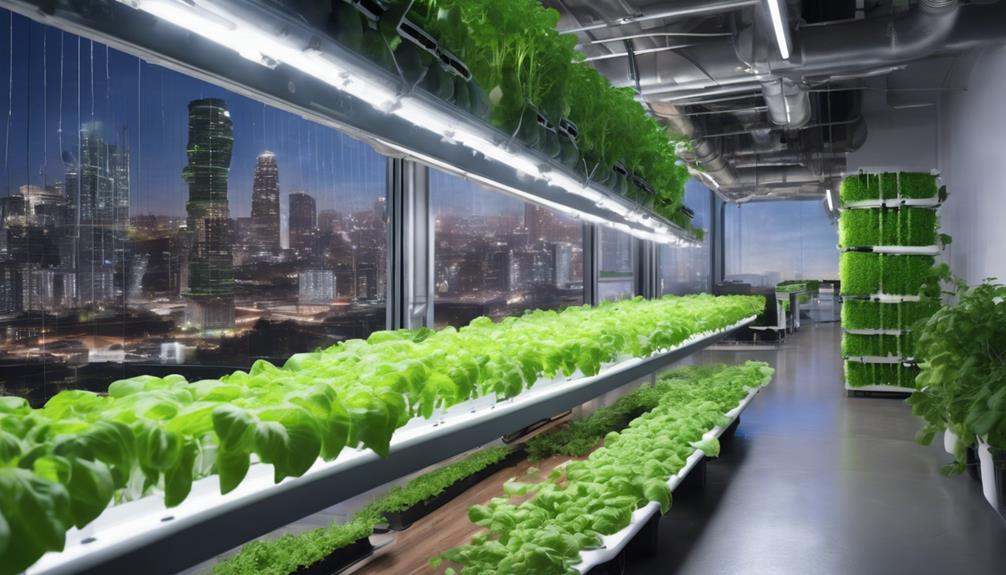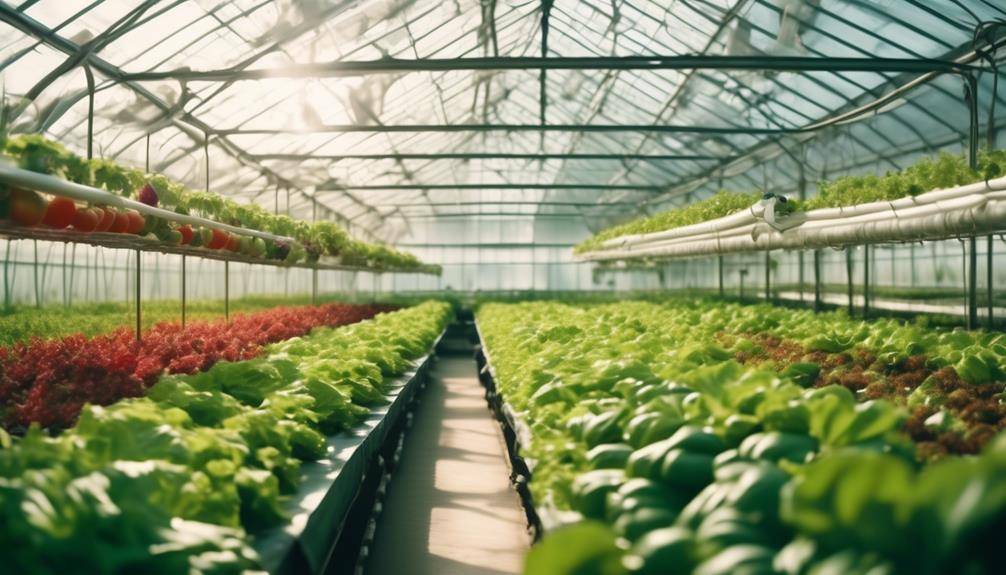Amazing Investment Opportunities In Vertical Farming Technologies

Investment Opportunities In Vertical Farming technologies is a smart move as urban agriculture grows and the demand for sustainable food solutions rises. You’ll find various systems like hydroponics and aeroponics that maximize yield while minimizing resource use. Plus, the market’s future is bright, driven by consumer interest in fresh, local produce and climate resilience. With supportive government policies and innovative funding options, your investment can play a role in reshaping our food systems. As you explore this exciting sector, more insights on key trends and technology advancements await you.
Overview of Vertical Farming
Vertical farming offers a groundbreaking solution to the challenges of traditional agriculture, transforming how we grow food. This innovative approach emphasizes urban agriculture, allowing you to cultivate crops in city environments where space is limited. With technology integration at its core, vertical farming utilizes advanced systems like hydroponics and aeroponics to maximize efficiency and yield.
By adopting sustainable practices, you can considerably reduce the environmental impact of food production. Vertical farms require less land and water, contributing to climate resilience and addressing food security concerns. You’ll find that by increasing crop diversity, vertical farming not only enhances nutritional value but also provides a wider range of produce options for local communities.
Community engagement plays an essential role in the success of vertical farming initiatives. When you involve local residents in the farming process, you foster a sense of ownership and pride. This engagement can be further enhanced through educational initiatives that teach sustainable practices and the importance of local sourcing. As you advocate for and participate in these programs, you help create a more informed and health-conscious community.
Market Growth Projections
As you explore the potential of vertical farming, it’s crucial to contemplate the global market trends shaping its future. Key growth drivers, like increasing urbanization and a rising demand for sustainable food sources, are set to propel this industry forward. Understanding these factors will help you identify lucrative investment opportunities in this rapidly evolving market.
Global Market Trends
Increasingly, analysts predict substantial growth in the vertical farming market, driven by rising consumer demand for fresh, locally sourced produce. This trend reflects a shift in consumer preferences towards sustainability and food security, pushing the investment landscape towards innovative solutions. As you explore market segmentation, you’ll notice various niches, including urban agriculture focusing on local communities and large-scale operations aiming for broader distribution.
Technological advancements play a significant role in this growth. They not only enhance crop yields but also reduce resource consumption, making vertical farming more appealing. Regional analysis shows that areas with high population density, like urban centers, present significant opportunities for expansion. The competitive landscape is evolving, with established agricultural companies and startups alike investing in cutting-edge technologies.
Moreover, sustainability trends are shaping business models and consumer choices, driving the demand for eco-friendly practices. By staying informed about these global market trends, you can better position yourself to capitalize on the burgeoning vertical farming sector, which promises not just profitability, but also a positive impact on our food systems and environment.
Key Growth Drivers
What factors are driving the rapid expansion of vertical farming? First, shifting consumer preferences are pushing for fresher, locally sourced produce, making urban agriculture an attractive solution. Technological advancements, such as LED lighting and automated systems, enhance efficiency and reduce operational costs, making vertical farms more viable.
Food security concerns amid population growth and climate change are essential drivers, as vertical farming offers climate resilience by producing food in controlled environments. The health benefits of consuming pesticide-free, nutrient-rich produce also resonate with health-conscious consumers, further boosting demand.
Moreover, a more efficient supply chain is important for reducing food waste and ensuring fresh produce reaches consumers quickly. However, you should be aware of investment risks, including high initial costs and market competition among new entrants.
Supportive policy frameworks can also play a significant role in fostering the growth of vertical farming, as governments increasingly recognize its potential benefits. By understanding these key growth drivers, you can better grasp the investment opportunities within vertical farming technologies and position yourself strategically in this evolving market.
Key Technologies in Vertical Farming
Harnessing advanced technologies, vertical farming is revolutionizing the way we produce food. One of the core components is hydroponic systems, allowing you to grow plants without soil, using nutrient-rich water instead. This method not only conserves resources but also accelerates growth cycles.
You’ll also benefit from advanced LED lighting. These energy-efficient lights provide the specific wavelengths plants need for peak growth, enabling year-round production regardless of outdoor conditions. Coupled with automation technology, you can streamline operations, reducing labor costs and improving efficiency.
Climate control is another significant technology. By managing temperature, humidity, and CO2 levels, you create an ideal environment for your crops. Combined with precise nutrient delivery systems, you guarantee that plants receive the right amounts of nutrients at the right times, enhancing yield and quality.
Soil alternatives play an important role as well, offering sustainable options like coconut coir or peat moss, which can improve aeration and moisture retention. Additionally, effective pest management solutions are essential to protect your crops without harmful chemicals, assuring a healthy harvest.
Utilizing data analytics, you can monitor plant health and environmental conditions in real-time, allowing for informed decision-making. Crop rotation techniques can also be implemented within modular designs, which enable you to maximize space and maximize output. All these technologies work together to create a sustainable, efficient, and productive vertical farming system, making it a promising investment opportunity for the future.
Types of Vertical Farming Systems
When exploring vertical farming systems, you’ll encounter several distinct types, each tailored to specific production needs and environments. One of the most popular options is hydroponic systems, where plants grow in nutrient-rich water instead of soil. This method allows for faster growth and higher yields, making it ideal for urban agriculture.
Another innovative approach is aeroponic techniques, which suspend plants in air and mist their roots with nutrients. This system maximizes oxygen exposure and minimizes water usage, enabling efficient growth in a controlled environment. Both hydroponic and aeroponic methods can be enhanced with LED lighting, which provides the specific light spectrum plants need for photosynthesis while reducing energy consumption.
Container farms are gaining traction in urban settings, utilizing modular designs to create compact, efficient growing spaces. These systems are perfect for optimizing limited space, allowing you to grow a variety of crops with impressive crop diversity. Automation solutions streamline operations, managing everything from nutrient delivery to climate control, further boosting efficiency.
Effective nutrient management is essential for success in any vertical farming system. By carefully controlling nutrient levels, you can guarantee healthy plant growth and maximize yields. With the combination of these diverse systems and technologies, you can tap into the potential of vertical farming to revolutionize food production and meet increasing demands. Whether you’re a seasoned investor or just starting, understanding these various types of vertical farming systems is key to identifying lucrative opportunities.
Environmental Benefits
Vertical farming presents a transformative solution to pressing environmental challenges, greatly reducing the resources needed for food production. By utilizing innovative techniques and controlled environments, you can markedly enhance climate resilience. These systems often require less water and energy, optimizing water management and promoting energy efficiency.
Soil conservation becomes a non-issue in vertical farms since they don’t rely on traditional soil farming. Instead, you can grow crops in nutrient-rich solutions or substrates, minimizing soil degradation. This method also supports biodiversity enhancement, as it allows for the cultivation of a diverse range of plants within urban agriculture settings.
Moreover, vertical farming contributes to food security by providing fresh produce closer to urban centers, reducing transportation emissions and spoilage. With efficient pest control methods, you can reduce reliance on harmful pesticides, creating healthier produce and contributing to overall health benefits for consumers.
Community engagement plays an essential role in vertical farming initiatives. You can involve local residents in growing efforts, fostering awareness about sustainable practices and the importance of food systems. This not only builds community ties but also educates individuals about the environmental impact of their food choices.
Economic Advantages
When you consider vertical farming, you’ll quickly see its economic advantages that can boost profitability. It offers cost efficiency through reduced resource usage and maximizes space, which means you can grow more with less. Plus, as market demand for fresh, local produce continues to rise, investing in this innovative approach could position you for significant returns.
Cost Efficiency Benefits
Cost efficiency in vertical farming presents a compelling opportunity for investors looking to optimize agricultural practices. By adopting these innovative systems, you can capitalize on significant cost savings and improve operational efficiency. Vertical farms often use advanced technologies, such as hydroponics and aeroponics, which minimize water and nutrient use compared to traditional farming. This reduction translates directly into lower utility bills and resource costs.
Moreover, vertical farming’s controlled environment enables year-round crop production, which means you won’t face the same seasonal fluctuations as outdoor farming. This consistency helps stabilize your revenue and reduces the risk associated with crop failures due to weather conditions.
Additionally, vertical farms are often located closer to urban centers, cutting down transportation costs and minimizing the carbon footprint of food delivery. You can pass these savings onto consumers, making your produce more competitive in the market.
Ultimately, investing in vertical farming technologies not only enhances your bottom line but also aligns with the growing demand for sustainable and efficient food production methods. By focusing on cost efficiency, you can position yourself advantageously in the evolving agricultural landscape.
Resource Utilization Optimization
Investing in vertical farming not only boosts cost efficiency but also maximizes resource utilization, leading to remarkable economic advantages. By focusing on enhanced resource allocation, you can reduce waste and increase the productivity of each square foot of your farming space. Vertical systems allow for precise control over water, nutrients, and light, ensuring that every resource is used to its fullest potential.
Effective energy management is another critical aspect of resource utilization. With advancements in LED technology and automated systems, you’ll find that energy consumption can be considerably reduced while still maintaining ideal growing conditions. This means you’re not just cutting costs; you’re also enhancing the sustainability of your operations.
Additionally, vertical farming systems can be designed to recycle water and nutrients, creating a closed-loop system that minimizes resource depletion. By investing in such technologies, you position yourself at the forefront of sustainable agriculture while maximizing your economic returns. This approach not only meets the growing demand for fresh produce but also sets you apart as a leader in resource-efficient farming practices. Harnessing these economic advantages will be key to your success in the vertical farming industry.
Market Demand Growth
The surge in consumer interest for locally sourced and sustainably grown produce has created a significant market demand for vertical farming. As you observe shifts in consumer preferences, you’ll notice that more people want fresh, nutritious food with a lower environmental impact. Vertical farming aligns perfectly with these desires, offering urban agriculture solutions that minimize transportation costs and reduce carbon footprints.
In urban areas, where space is often limited, vertical farms can thrive, providing fresh produce right where people live. This accessibility not only satisfies consumer cravings for local food but also fosters community engagement. You’ll find that urban dwellers are increasingly willing to invest in these innovative farming methods, as they recognize the benefits of supporting local economies and sustainable practices.
Moreover, as the global population continues to rise, the demand for efficient food production systems is paramount. Vertical farming meets this challenge by maximizing yields in smaller spaces, ultimately leading to economic advantages. Investing in vertical farming technologies not only fulfills current consumer demands but also positions you for future growth in a rapidly evolving market. Embrace this opportunity to be part of a sustainable food revolution.
Investment Trends
In recent years, a surge of interest in vertical farming has transformed the agricultural landscape, making it an attractive option for savvy investors. As you explore investment trends in this sector, you’ll notice that the focus has shifted toward innovative investment strategies that leverage technological advancements. Investors are keen on conducting thorough impact assessments to understand how vertical farming can yield sustainable returns.
Market segmentation plays a significant role in identifying specific niches within the vertical farming market. By analyzing different segments, you can tailor your investment strategies to target high-growth areas. Risk mitigation is another important factor; diversifying your portfolio across various vertical farming technologies helps you balance potential risks.
Funding sources are evolving, with a mix of venture capital, government grants, and crowdfunding options now available. Understanding investor profiles is essential, as each type of investor—whether institutional or individual—brings unique expectations and risk tolerances to the table. Engaging in competitive analysis will help you stay informed about emerging players and technologies that could impact your investments.
Lastly, developing exit strategies should be a priority. Knowing when and how to exit your investments can maximize your returns. As you navigate this dynamic landscape, keep in mind the importance of portfolio diversification. By spreading your investments across various vertical farming initiatives, you position yourself to capitalize on the sector’s growth while minimizing risk.
Major Players in the Industry
Vertical farming is rapidly evolving, and major players in the industry are driving this transformation. Key market leaders like AeroFarms, Plenty, and Bowery Farming are at the forefront, showcasing impressive technology advancements that enhance efficiency and sustainability. These companies are not just innovating in isolation; they’re forming strategic collaborations with research initiatives and industry partnerships to push the boundaries of what’s possible.
Investor interest in vertical farming has surged, leading to diverse funding sources, from venture capital to public-private partnerships. This influx of capital fuels innovation hubs where new ideas and technologies can flourish. As you explore the competitive landscape, it becomes clear that the integration of advanced technologies, such as AI and IoT, is essential in reshaping supply chain dynamics.
Moreover, companies are leveraging data analytics and automation to streamline operations and reduce costs. This is vital in a sector where efficiency can make or break profitability. The partnerships formed between established agricultural firms and tech startups are particularly significant, as they allow for rapid scaling of new solutions across the industry.
As the market matures, expect to see more players entering the field, each bringing unique approaches to vertical farming. The ongoing evolution will likely lead to enhanced competition, pushing existing players to innovate continuously. Keeping an eye on these major players and their strategic moves will be essential for anyone looking to invest in vertical farming technologies.
Government Support and Incentives
Harnessing government support and incentives can greatly boost the vertical farming sector. By taking advantage of government subsidies, you can reduce startup costs and make your investment more viable. Many governments offer tax incentives for sustainable agricultural practices, which can substantially enhance your bottom line. Additionally, grant programs aimed at innovative farming technologies provide essential financial support for your projects.
Engaging in public-private partnerships allows you to collaborate with local governments, leveraging resources and expertise to create a more efficient operation. Understanding the regulatory frameworks and agricultural policies in your area is vital, as they can dictate the incentives available to you. Some regions prioritize urban agriculture support, recognizing its potential to address food security and environmental concerns.
Moreover, innovation funding can help you develop cutting-edge solutions that meet environmental regulations while promoting sustainability initiatives. With these funds, you can invest in technology that enhances efficiency and reduces waste, making your vertical farm more competitive.
It’s essential to stay informed about the latest government policies and incentives, as these can change frequently. By aligning your farming strategies with these initiatives, you can position yourself for success. Embracing government support not only strengthens your business model but also contributes to broader sustainability goals, ensuring that your vertical farming venture thrives in an evolving landscape. So, be proactive in seeking out available resources and support to maximize your investment in vertical farming technologies.
Challenges and Risks
When considering vertical farming, you can’t overlook the high initial capital investment required to get started. Additionally, managing regulatory compliance can be a intimidating task that may slow down your progress. Understanding these challenges is essential to making a smart investment decision.
High Initial Capital Investment
Investing in vertical farming presents a significant challenge due to the high initial capital investment required. This upfront cost often includes advanced technology, infrastructure, and equipment, making meticulous financial planning vital. You’ll need to conduct thorough market analysis to identify viable funding sources and guarantee your investment aligns with return expectations.
Effective risk assessment is essential here. Understanding the potential pitfalls can help you refine your capital allocation strategy. It’s wise to take into account investment diversification to spread risk across different projects or technologies. Engaging in solid investor relations can also attract additional funding and bolster your cash flow.
Profit margins can be tight initially, so keeping a close eye on operational efficiency is key. Establishing a robust financial strategy will help you navigate the complexities of cash flow management in the early stages. As you move forward, remember that the high initial costs are often offset by the long-term gains of vertical farming. By addressing these challenges head-on, you can position yourself for success in a rapidly evolving market.
Regulatory Compliance Hurdles
Steering through the landscape of vertical farming isn’t just about managing financial investments; regulatory compliance presents its own set of challenges and risks. You’ll need to navigate complex regulatory frameworks that vary by region, which can lead to compliance challenges that feel overwhelming.
Understanding safety standards is essential, as these will dictate how you operate and what materials you can use. Zoning laws can also complicate your plans, as not all areas allow for vertical farming operations. You’ll have to familiarize yourself with the certification processes necessary to prove your farm meets industry regulations, ensuring you don’t face any unexpected legal implications.
Liability concerns are another vital aspect; any failure to adhere to operational guidelines could result in significant financial repercussions. This makes it imperative to stay updated on permit requirements, as they can change and impact your ability to operate smoothly. Ignoring these factors could jeopardize your investment, so proactive engagement with regulatory bodies is key. By addressing these compliance hurdles head-on, you’ll position your vertical farming venture for long-term success.
Case Studies of Successful Farms
Vertical farming has proven to be a game-changer in urban agriculture, with several successful farms setting the standard for innovation and sustainability. One standout example is a farm in New York City that’s embraced automation integration and technology partnerships to optimize its operations. By utilizing advanced sensors and climate control systems, they’ve managed to achieve impressive crop diversity, growing everything from leafy greens to herbs year-round. This adaptability not only maximizes yield but also attracts a variety of consumers keen for fresh produce.
Another inspiring case is a community-focused vertical farm in Detroit, which prioritizes community involvement and educational initiatives. Here, local residents engage in hands-on workshops, learning about sustainable practices and the benefits of urban farming. This farm has fostered a sense of ownership among community members, enhancing consumer engagement and promoting healthier eating habits.
Additionally, research collaborations with universities have allowed these farms to innovate continuously. They test new growing methods and share findings that benefit the broader agricultural community. These partnerships not only improve farming techniques but also provide students with invaluable real-world experience.
Through these case studies, you can see how successful vertical farms are not just about technology; they’re about creating a holistic ecosystem that involves the community, embraces change, and champions sustainability. Investing in such initiatives not only promises financial returns but also nurtures a healthier planet and society.
Future Innovations and Trends
As the world grapples with food security and environmental challenges, innovations in urban agriculture are poised to transform how we grow food. You’ll see the rise of robotic automation and AI integration, streamlining operations and enhancing efficiency. These technologies will not only reduce labor costs but also improve precision in crop management, allowing for better resource utilization.
Sustainable materials will play a vital role in the future of vertical farming. You’ll find farms utilizing biodegradable containers and energy-efficient systems, contributing to climate resilience and reducing their carbon footprint. Modular designs will also gain traction, enabling farms to expand or adapt based on consumer preferences and market demand. This scalability potential makes urban agriculture an attractive option for investors.
Crop diversity is another trend you’ll want to watch. As consumers demand a wider variety of fresh produce, vertical farms will respond by cultivating an array of crops, from leafy greens to exotic fruits. This adaptability not only meets consumer preferences but also enhances food security by reducing reliance on traditional agricultural practices.
Funding Opportunities for Startups
Finding funding opportunities for startups in vertical farming can be a game-changer for entrepreneurs looking to make an impact in the agricultural sector. With the increasing interest in sustainable food production, you’ll find various avenues to secure financial support. Angel investments are often the first step, as individual investors can provide seed funding to propel your innovative ideas forward.
Venture capital firms are also keen on backing promising startups, especially those focusing on technology-driven solutions in vertical farming. Additionally, crowdfunding platforms allow you to reach a wider audience, enabling everyday supporters to contribute to your vision.
Consider joining startup accelerators or incubator programs that offer not only funding but also mentorship and resources to help you grow. These programs can connect you with vital financial partnerships, enhancing your credibility and network.
Impact investing is another exciting option, as many investors look for opportunities that yield both financial returns and positive social outcomes. Exploring grant opportunities from government agencies or private organizations can provide non-dilutive funding that doesn’t require giving up equity.
Lastly, equity financing remains a staple for many startups, allowing you to raise capital by selling shares in your company. By diversifying your funding sources and leveraging these opportunities, you’ll be well on your way to establishing a successful vertical farming venture.
Sustainable Practices in Vertical Farming
In vertical farming, resource efficiency is key to maximizing outputs while minimizing inputs. You can implement strategies that optimize water and energy use, ensuring sustainability without sacrificing productivity. Additionally, waste reduction techniques can transform byproducts into valuable resources, further enhancing your farm’s eco-friendly profile.
Resource Efficiency Strategies
Vertical farming transforms how we think about agriculture by maximizing resource efficiency through innovative practices. By utilizing cutting-edge technology, you can effectively implement water conservation strategies that dramatically reduce usage compared to traditional farming methods. Systems like hydroponics and aeroponics allow you to grow plants without soil, using considerably less water while delivering nutrients directly to their roots. This method not only saves water but also promotes faster growth cycles, increasing your yield.
Energy management is another vital aspect of resource efficiency in vertical farming. You can optimize energy use by incorporating energy-efficient LED lighting systems that mimic natural sunlight, consuming less power while enhancing photosynthesis. Additionally, integrating renewable energy sources, like solar panels, can further decrease your reliance on grid energy, reducing operational costs and environmental impact.
Waste Reduction Techniques
Maximizing resource efficiency not only involves water and energy but also focuses on minimizing waste. In vertical farming, implementing waste reduction techniques can greatly enhance sustainability. One effective approach is waste recycling, where you can repurpose materials that would otherwise end up in landfills. By employing composting methods, you can convert organic waste into nutrient-rich soil amendments, promoting nutrient management and improving plant growth.
Water conservation is another critical aspect; capturing and reusing water from irrigation systems can drastically lower your overall consumption. Likewise, energy efficiency measures, such as using LED lighting and energy-efficient climate controls, can reduce your operational costs while minimizing your carbon footprint.
Don’t overlook packaging innovations, as they can help reduce waste associated with product distribution. By focusing on byproduct utilization, you can find creative ways to turn excess materials into valuable resources, such as biofuels or animal feed. Ultimately, these waste reduction techniques not only contribute to a more sustainable operation but also enhance your investment potential by attracting eco-conscious consumers and partners. Embrace these practices to position yourself at the forefront of the vertical farming revolution.
Conclusion and Call to Action
As the world increasingly faces food supply challenges, investing in vertical farming presents a unique opportunity for both sustainability and profitability. This innovative approach not only promises to address future predictions of food scarcity but also enhances community impact by providing fresh produce locally. By reducing transportation costs and minimizing waste, vertical farming can transform how your community accesses healthy food options.
Now’s the time to reflect on how you can get involved in this burgeoning industry. Whether you’re an investor looking for profitable ventures or an entrepreneur enthusiastic to explore new business models, vertical farming is ripe for exploration. You can participate in shaping the future of agriculture by supporting startups and established companies developing cutting-edge technologies.
Moreover, the community impact of your investment can’t be understated. As urban areas grow, the demand for sustainable food sources increases. By investing in vertical farms, you’re not just generating returns; you’re contributing to local economies, creating jobs, and promoting healthier lifestyles.
Investment Opportunities In Vertical Farming; Frequently Asked Questions
What Are the Main Nutritional Benefits of Vertically Farmed Produce?
Vertically farmed produce offers high nutrient density, enhanced flavor profiles, and longer shelf life. By employing sustainable practices and crop rotation, you’ll enjoy fresher, healthier food while minimizing environmental impact. It’s a win-win for everyone!
How Do Vertical Farms Ensure Pest Control Without Chemicals?
You’ll find that vertical farms use biological pest management and integrated pest strategies to control pests naturally. By encouraging beneficial insects and employing physical barriers, they reduce reliance on chemicals while maintaining healthy crops.
What Crops Grow Best in Vertical Farming Systems?
When considering crop selection for vertical farming, focus on leafy greens like lettuce and herbs, as they thrive in these systems. Their rapid growth rates maximize efficiency and yield, making them ideal choices for your farm.
How Do Vertical Farms Impact Local Job Markets?
Vertical farms boost local job markets by creating new positions and opportunities. They often require workforce training, equipping individuals with skills in agriculture technology, sustainability, and management, fostering economic growth and community development in the process.
Can Vertical Farming Be Implemented in Urban Areas Effectively?
You can implement vertical farming effectively in urban areas by utilizing space optimization techniques. Urban agriculture thrives in limited spaces, allowing you to grow fresh produce while maximizing resources and reducing transportation costs for city residents.
Conclusion
To sum up, vertical farming offers a promising investment opportunity that’s hard to ignore. By embracing innovative technologies and sustainable practices, you can contribute to a greener future while tapping into a rapidly growing market. As you consider funding or investing in this field, keep an eye on emerging trends and advancements. Now’s the time to get involved and support a solution that not only meets food demands but also benefits the environment. Let’s grow together!








